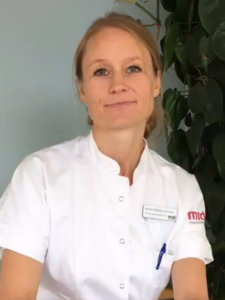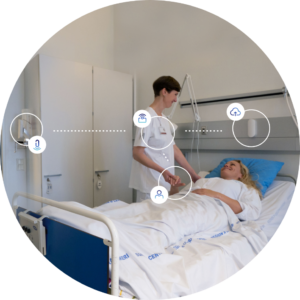How a call for behavior change led to innovative solutions to better hand hygiene in a hospital in Denmark
Published: June 10, 2019
Anne-Mette Iversen is a clinical nursing specialist at Aarhus University Hospital in Denmark. She graduated with a master’s degree in humanities and health studies at Aarhus University. For the past four years, she has emphasized the importance of hand hygiene in the Oncology Department at Aarhus University Hospital, working closely with nurses and doctors to educate and encourage good hygiene in all aspects to improve patient safety and stop the spread of infection.
A call for hand hygiene behavior change
As a nursing specialist, Anne-Mette saw a big problem in her hospital’s oncology department – hand hygiene compliance during critical moments of care (e.g. after using the toilet, before patient contact) was lacking. While the hospital had certain hand hygiene guidelines in place, such as e-training and a hygiene specialist for each department, healthcare-associated infections were still a huge problem. In Denmark, 60,000 patients acquire a healthcare-associated infection during in-patient care each year. These infections are especially detrimental for oncology patients due to their weakened immune system.
Despite her colleagues stating they performed hand hygiene 100% of the time, her direct observations showed otherwise. While she knew hand hygiene compliance was an issue, she did not know how to go about changing behavior. It is a common occurrence for individuals to say and even believe that they are performing proper hand hygiene during all critical moments of care, but they are overestimating their own performance (this is known as the Dunning-Kruger effect, a cognitive bias). “How do I work with an area when staff tell me they do it right, but I’m not sure if they do… It’s hard because I don’t know how to change that behavior,” she says, describing how hand hygiene rates had not been accurately measured in the oncology department previously.
With limited experience in behavior change, Anne-Mette mobilized a group of behavior change specialists, facility leaders, and engineers, who agreed to help her improve hand hygiene at Aarhus University Hospital. After discussions, they concluded that if staff did not know the behavior (in this case, hand hygiene practices), then they could not change it. While direct observations by secret observers are important in measuring hand hygiene compliance, the method leaves gaps in tracking all hand hygiene opportunities. By developing an electronic monitoring system based on WHO’s 5 Moments for Hand Hygiene, they would be able to more accurately measure compliance rates among staff and thus tailor their hand hygiene messages accordingly.
Developing and implementing a new system
Sani nudge is a sensing technology system that works by using sensors on alcohol dispensers, staff name badges, and throughout key areas around the oncology department (e.g. staff toilet, patient room entrance/exit, and patient bedside). The system determines whether a staff member has encountered a critical moment for hand hygiene (e.g. in contact with a patient) and whether alcohol-based handrub was used to clean their hands. Through this system, facility leaders can continuously measure and improve staff hand hygiene.
Figure 1: The image below provides an illustration of how the Sani nudge system works.
Sani nudge is a unique sensing system because unlike other systems, it considers previous workflow rather than looking at hand hygiene compliance through isolated situations. For instance, a health worker could go from the toilet to the office and subsequently to a patient room. The system then tracks their movements and determines whether they have been in a situation that requires hand hygiene and if hand hygiene is actually performed.
Anne-Mette and her team originally tested the system on nurses within the oncology department at Aarhus University Hospital. Prior to implementation, general handwashing signs and e-mails were sent out to remind staff to clean their hands. Anne-Mette says, “At first, the staff was nervous. A badge that monitors all of your movements can seem scary, especially because these nurses had not worked with data like this before.” While there was some initial hesitance, the use of data proved to be useful for both leaders and nurses to visualize their hand hygiene practices. With the facility leaders championing the implementation of this new system from the start, staff members were also able to see the benefits of using Sani nudge to track their behaviors and improve their hand hygiene.
Measuring and reinforcing hand hygiene compliance
The system tracked hand hygiene compliance throughout the oncology department, and soon, Anne-Mette had data to back up her observations. The data showed that hand hygiene compliance was often highest in the mornings and decreased as the day continued. It noted that the morning hours were also where nurses had the highest amount of patient contact. Anne-Mette further explains, “A benefit to the Sani nudge system is the ability to track hand hygiene opportunities 24 hours a day, so that staff can better understand hand hygiene patterns around their unit.”
Furthermore, the system allows individuals to see data of their own hand hygiene compliance. Staff members who had a lower compliance at the beginning when the system was installed did increase their hand hygiene activity, but still had the lowest compliance when compared to other staff members in the department. Because the system sends individual data to each staff member on their hand hygiene rates, they can see a breakdown of their activities and behaviors, keeping them more accountable to perform hand hygiene during critical moments of care.
While the sensing technology helped track compliance rates, the system alone was not enough. Leadership and communication were equally important. An initial problem area they saw was around the staff toilet. Prior to the intervention, hand hygiene compliance around the staff toilet was less than 40%; this is now at a steady 90%. Hand hygiene compliance after patient contact also drastically improved. However, hand hygiene rates before patient contact and in the medicine room continue to show lower compliance, which indicates the need to focus on those areas when targeting hand hygiene messaging.
Every Wednesday, Anne-Mette shows the system’s data to staff and discusses situations that they could focus on to improve hand hygiene. Showing the data to staff members each week has been useful in increasing accountability and compliance among staff. By encouraging staff members to play an active role in setting goals, it adds the element of group engagement to their hand hygiene improvement and initiates a culture change. Patients have also reinforced hand hygiene compliance among staff. Likewise, the visual nudge associated with the Sani nudge system (a green light verifying proper hand hygiene status) reminds staff members to clean their hands at critical times and thus promotes good hand hygiene. Anne-Mette noted, “The culture around the hospital has changed to have more accountability because of the Sani nudge system, which helps reinforce hand hygiene compliance.”
What’s next?
This project proved that one person’s call to action can impact a hospital’s culture around hand hygiene. In this case, Anne-Mette was able to mobilize a group of individuals with different expertise to develop and test an innovative solution to measure hand hygiene compliance. By advocating for an issue that she was passionate about, Anne-Mette was able to leverage her resources to ultimately increase hand hygiene practices within the oncology department at Aarhus University Hospital. Anne-Mette and her team hope to expand Sani nudge hospital-wide with the help of facility leaders.
Moving forward, Anne-Mette hopes to use Sani nudge data in scientific studies and hopes to measure the impact of the system on healthcare-associated infections in the future. When asked about her biggest takeaway from her hand hygiene work, Anne-Mette said, “We need to use knowledge from different specialists to develop solutions to this problem. That was the key to design this system and that enabled the hospital to change the hand hygiene culture for the better by integrating technology and data.”
Photos courtesy of Anne-Mette Iversen and Sani nudge.
TAGS: Case Study Hygiene in Health FacilitiesRx Hand Hygiene 2019

